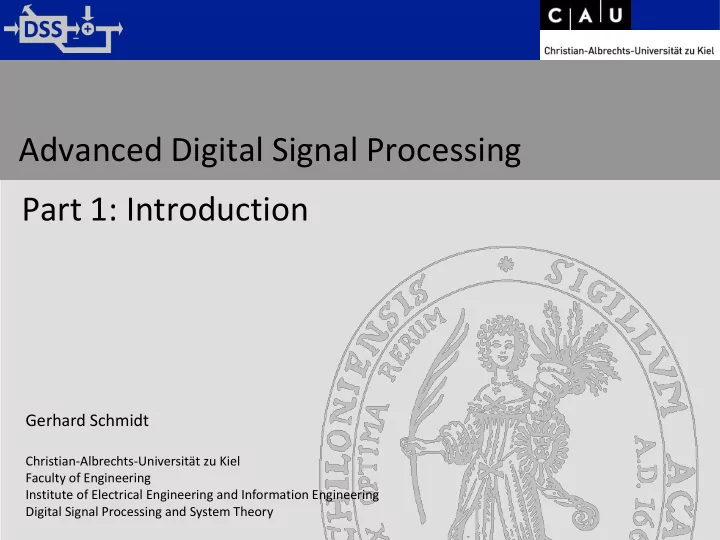

Advanced Digital Signal Processing Part 1: Introduction Gerhard Schmidt Christian-Albrechts-Universität zu Kiel Faculty of Engineering Institute of Electrical Engineering and Information Engineering Digital Signal Processing and System Theory
Introduction Contents of the Lecture – Part 1 Introduction Digital processing of continuous-time signals Sampling and sampling theorem (repetition) Quantization Analog-to-digital (AD) and digital-to-analog (DA) conversion DFT and FFT Leakage effect Windowing FFT structure Digital filters FIR filters IIR filters Finite word-length effects Digital Signal Processing and System Theory| Advanced Digital Signal Processing | Introduction Slide I-2
Introduction Contents of the Lecture – Part 2 Multi-rate digital signal processing Decimation and interpolation Filters in sampling rate alteration systems Polyphase decomposition and efficient structures Digital filterbanks Digital Signal Processing and System Theory| Advanced Digital Signal Processing | Introduction Slide I-3
Introduction Origin of this lecture In Addition … Thanks to … … Prof. Dr. -Ing. Jörg Kliever … Dr. -Ing. Halil Özer and (slides are based on his script that Dipl.-Wirtsch.-Ing. Duc Nguyen he has written during his time at the Christian-Albrechts-Universität helped preparing the lecture slides: zu Kiel) Dr. Halil Özer Prof. Kliewer is now with: CAU, DSS group Klipsch School of Electrical and Computer Engineering New Mexico State University, USA Duc Nguyen CAU, DSS group Digital Signal Processing and System Theory| Advanced Digital Signal Processing | Introduction Slide I-4
Introduction Literature Books: J. G. Proakis, D. G. Manolakis: Digital Signal Processing: Principles, Algorithms, and Applications , Prentice Hall, 1996, 3rd edition S. K. Mitra: Digital Signal Processing: A Computer-Based Approach , McGraw Hill Higher Education, 2000, 2nd edition A. V. Oppenheim, R. W. Schafer: Discrete-Time Signal Processing , Prentice Hall, 1999, 2nd edition M. H. Hayes: Statistical Signal Processing and Modeling , John Wiley and Sons, 1996 Digital Signal Processing and System Theory| Advanced Digital Signal Processing | Introduction Slide I-5
Introduction Signals, Systems and Signal Processing – Part 1 What does “Digital Signal Processing” mean? The term “Signal” in “Digital Signal Processing”: Physical quantity that varies with time, space, or any other independent variable Mathematically: Function of one or more independent variables, Examples: Temperature over time , brightness (luminance) of an image , pressure of a sound wave over or Speech signal: Digital Signal Processing and System Theory| Advanced Digital Signal Processing | Introduction Slide I-6
Introduction Signals, Systems and Signal Processing – Part 2 What does “Digital Signal Processing” mean? The term “Signal Processing” in “Digital Signal Processing”: Passing the signal through a system Examples: Modification of the signal (filtering, interpolation, noise reduction, equalization, …) Prediction, transformation to another domain (e.g. Fourier transform) Numerical integration and differentiation Determination of mean value, correlation, probability density function, … Properties of the system (e.g. linear/nonlinear) determine the properties of the whole processing operation The definition of a system also includes: Software realizations of operations on a signal, which are carried out on a digital computer (software implementation of the system), digital hardware realizations (logic circuits) configured such that they are able to perform the processing operation, or most general definition: a combination of both . Digital Signal Processing and System Theory| Advanced Digital Signal Processing | Introduction Slide I-7
Introduction Signals, Systems and Signal Processing – Part 3 What does “Digital Signal Processing” mean? Finally “Digital Signal Processing”: Processing of signals by digital means (software and/or hardware) This includes: Conversion from the analog to the digital domain and back (physical signals are analog) Mathematical specification of the processing operations (Algorithm: method or set of rules for implementing the system by a program that performs the corresponding mathematical operations) Emphasis on computationally efficient algorithms , which are fast and easily implementable. Digital Signal Processing and System Theory| Advanced Digital Signal Processing | Introduction Slide I-8
Introduction Basic Elements of a Digital Signal Processing System Analog signal processing: Analog Analog Analog input signal output signal processing signal Digital signal processing: Analog Digital Analog DA AD signal input output converter converter Digital Digital signal processing signal input output signal signal Digital Signal Processing and System Theory| Advanced Digital Signal Processing | Introduction Slide I-9
Introduction Why has digital signal processing become so popular? Advantages and disadvantages of digital processing compared to analog processing: Property Digital processing Analog processing Dynamics Only limited by complexity Generally limited Precision Generally unlimited Generally limited (costs (costs and complexity prop. to increase drastically with precision) required precision) Aging Without problems Problematic Production costs Low Higher Frequency range Limited Nearly unlimited Linear-phase frequency Exactly realizable Approximately realizable responses Complex algorithms Realizable Strong limitations However, digital signal processing has always also analog components (amplifiers, etc.). Digital Signal Processing and System Theory| Advanced Digital Signal Processing | Introduction Slide I-10
Digital Processing of Continuous-Time Signals Summary Introduction Contents of the lecture Literature Analog versus digital signal processing Digital processing of continuous-time signals DFT and FFT Digital filters Multi-rate digital signal processing Digital Signal Processing and System Theory| Advanced Digital Signal Processing | Introduction Slide I-11
Recommend
More recommend